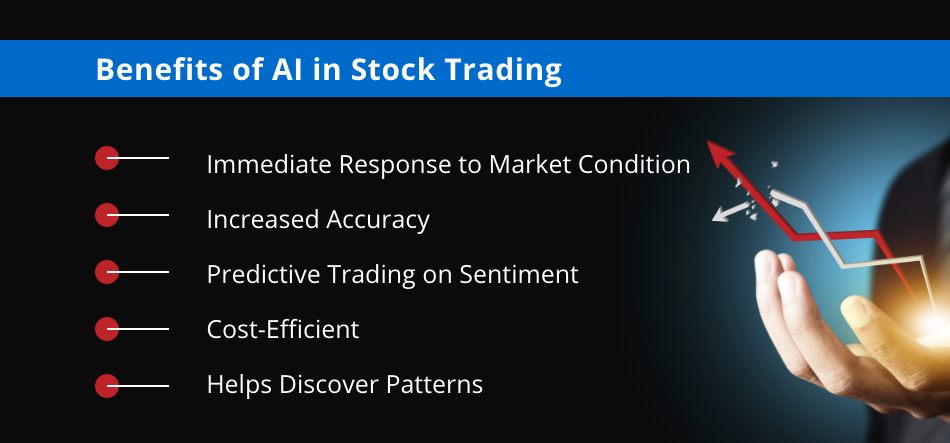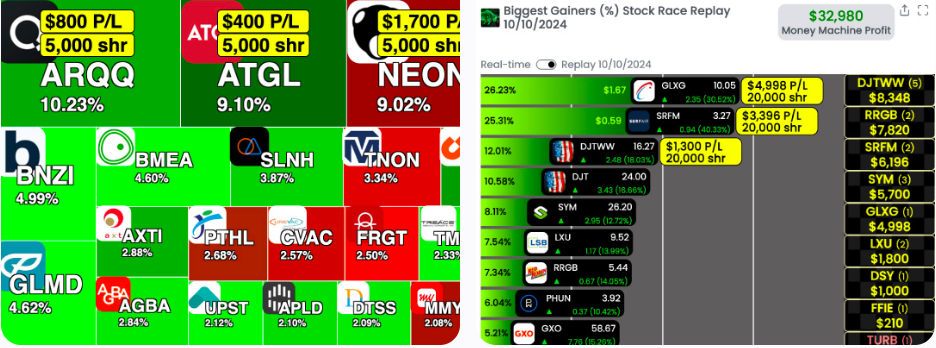Top 10 Things To Consider When Evaluating Ai And Machine Learning Models On Ai Trading Platforms For Stocks
Analyzing the AI and machine learning (ML) models used by stock prediction and trading platforms is crucial in order to ensure that they are precise, reliable, and actionable insights. A model that is not well-designed or overhyped could result in incorrect predictions as well as financial loss. Here are 10 top methods to evaluate AI/ML models that are available on these platforms.
1. Learn the purpose of the model and its approach
Objective: Determine if the model was created for short-term trades as well as long-term investments. Also, it is a good tool for sentiment analysis or risk management.
Algorithm transparency: See if the platform provides information on the kinds of algorithms used (e.g. regression and decision trees, neural networks, reinforcement learning).
Customization: See whether the model could be tailored to your specific trading strategy or risk tolerance.
2. Evaluation of Performance Metrics for Models
Accuracy: Check the model's prediction accuracy however, don't base your decision solely on this measure, since it can be misleading in financial markets.
Recall and precision: Determine whether the model is able to identify true positives (e.g. accurately predicted price moves) and reduces false positives.
Risk-adjusted returns: Find out if the model's forecasts result in profitable trades after adjusting for risk (e.g. Sharpe ratio, Sortino coefficient).
3. Check your model by backtesting it
Backtesting the model by using the data from the past allows you to compare its performance with previous market conditions.
Tests with data that were not being used to train: To avoid overfitting, test the model using data that was not previously used.
Scenario analysis: Test the model's performance under various market conditions (e.g. bear markets, bull markets high volatility).
4. Be sure to check for any overfitting
Overfitting: Look for models that perform well with training data, but don't perform as well with data that has not been observed.
Regularization methods: Check the application uses methods like regularization of L1/L2 or dropout to prevent overfitting.
Cross-validation is essential: the platform should utilize cross-validation to assess the model generalizability.
5. Examine Feature Engineering
Relevant features: Verify that the model includes relevant attributes (e.g. price, volume and technical indicators).
The selection of features should be sure that the platform selects features with statistical significance and avoid unnecessary or redundant information.
Dynamic feature updates: Determine that the model can be adapted to the latest characteristics or market conditions in the course of time.
6. Evaluate Model Explainability
Readability: Ensure the model provides clear explanations of its predictions (e.g. SHAP value, the importance of the features).
Black-box model Beware of applications that make use of models that are overly complex (e.g. deep neural network) without describing tools.
User-friendly insights : Check whether the platform provides actionable information in a format that traders can use and understand.
7. Examine Model Adaptability
Market shifts: Find out whether the model is able to adapt to changes in market conditions, such as economic shifts or black swans.
Check for continuous learning. The platform should be updated the model frequently with new information.
Feedback loops: Ensure that the platform is incorporating feedback from users or real-world results to help refine the model.
8. Examine for Bias in the elections
Data bias: Check whether the information used in the training program are accurate and does not show bias (e.g. or a bias toward certain industries or times of time).
Model bias - Determine whether your platform is actively monitoring, and minimizes, biases in the model predictions.
Fairness - Ensure that the model you choose to use isn't biased in favor of or against particular sectors or stocks.
9. Evaluate the effectiveness of Computational
Speed: Determine whether a model is able to make predictions in real-time with minimal latency.
Scalability: Determine whether a platform is able to handle multiple users and large data sets without affecting performance.
Resource usage: Check whether the model is using computational resources effectively.
Review Transparency, Accountability, and Other Questions
Model documentation: Make sure the platform is able to provide detailed documentation on the model's design, structure as well as its training process, as well as its limitations.
Third-party audits: Verify if the model has been independently audited or validated by third parties.
Make sure there are systems in place to detect errors and failures of models.
Bonus Tips
User reviews and case studies: Use user feedback and case studies to gauge the real-world performance of the model.
Trial period: Try the model free of charge to test how accurate it is and how simple it is to utilize.
Support for customers: Ensure that the platform provides robust support for technical or model issues.
If you follow these guidelines by following these tips, you will be able to evaluate the AI and ML models of stocks prediction platforms, making sure they are trustworthy as well as transparent and in line with your trading objectives. Read the top rated ai investment app for site examples including best ai trading app, ai stock trading bot free, ai stock trading, ai investment app, ai investing app, best ai for trading, chatgpt copyright, ai chart analysis, chart ai trading assistant, ai stock trading and more.

Top 10 Ways To Evaluate The Regulatory Compliant Of Ai Stock Forecasting/Analyzing Trading Platforms
Regulation compliance is a key element to evaluate trading platforms that use AI. Compliance assures that a platform's operations are within legal frameworks. Users data is protected and financial regulations are complied with and minimizes the chance of legal problems. Here are top 10 tips for evaluating the level of compliance these platforms have.
1. Verify the Licensing & Registration
Regulators: Make sure your platform is registered with and regulated by the appropriate financial regulatory authorities (e.g., SEC in the U.S., FCA in the UK, ASIC in Australia).
Broker partnership: If a platform incorporates brokers, ensure that the brokers are licensed and properly regulated.
Public records: Visit the official website of the regulator to verify the status of registration and past violations.
2. Examine the privacy of your data Compliance
GDPR: If you are operating or providing services to users in the EU, make sure that your platform is in compliance to the General Data Protection Regulation.
CCPA For those who reside who reside in California Verify that they are in compliance with the California Consumer Privacy Act (CCPA).
Policy on handling data: Make sure that you go through the platform's privacy policies to understand how users' data is stored and collected.
3. Examine Anti-Money Laundering(AML) measures
AML policies: Ensure the platform is equipped with strong AML policies to prevent and detect money laundering activities.
KYC procedures - Verify that the platform complies with Know Your Customer procedures for verification of user identities.
Transaction monitoring: Find out if your platform monitors all transactions for suspicious activities and reports them to the authorities.
4. Make sure you're in compliance Trading Regulations
Market manipulation: Make sure that the platform has measures to stop market manipulations such as fake trading, wash trading.
Types of orders. Verify that the platform is in compliance with all regulations regarding order type (e.g. there is no illegal stop loss hunting).
Best execution: Make sure to see if the platform is adhering to the best execution method, which ensures that trades will be executed at the cheapest price.
5. Assessment of Cybersecurity's compliance
Data encryption: Ensure that the platform is secure for users' data during its travel and also when it is in rest using encryption.
Response to incidents. Verify whether the platform has a plan of action for handling cybersecurity breaches and data breaches.
Certifications: Verify if the platform has cybersecurity certifications.
6. Transparency as well as Disclosure and Evaluation
Fee disclosure: Make sure the platform discloses all charges that are hidden, as well as any additional fees.
Risk disclosure: Check if there are clear and explicit disclosures about the risk, especially in high-risk or leveraged trading strategies.
Performance reporting: Determine whether the AI platform's models are clear and accurately reported.
7. Check for the conformity to International Regulations
Cross-border Trading: If your trading is international You must make sure that the platform you use meets the requirements of each regulatory jurisdiction.
Tax reporting: Determine whether a platform offers tools or reports for users to comply with tax regulations.
Sanctions compliance: Make sure the platform is compliant with international sanctions and is not allowing trading with prohibited entities or countries.
8. Assess Record-Keeping & Audit Trails
Transaction records: Ensure that your platform has detailed records of every transaction, both for reasons of auditing and regulatory purposes.
User activity records: Verify whether the platform is recording users' activities, such as logins or trades, as well as any modifications to account settings.
Audit readiness: Make sure that the platform has the necessary documentation and logs in the case an audit by a regulatory agency.
9. Verify compliance with AI Specific Regulations
Algorithmic trading regulations: If you're using a platform which supports algorithmic trading, make sure it is compatible with relevant regulatory frameworks such as MiFID II or Reg SCI which are in Europe and the U.S.
Fairness and Bias: Make sure that the platform detects, and mitigates, biases within its AI models to guarantee fair trade.
Explainability: As stipulated by specific regulations, the system should provide clear explanations of AI-driven predictions and decisions.
Review User Feedback & Review History of Regulatory History
User feedback: Read user reviews to assess the credibility of the platform in terms of compliance with the law.
History of regulation: Determine whether the platform has any records of violations to the law such as fines, penalties, or sanctions.
Third-party audits: Verify that the platform has regular audits by a third party to ensure compliance with regulations.
Bonus Tips
Legal consultation: Talk to a legal expert about the compliance of the platform with relevant regulations.
Trial period: Try the platform for free or utilize the demo feature to test out its compliance features and the documentation.
Customer support - Make sure that the platform is able to assist with any compliance related questions or issues.
Utilizing these suggestions you can identify the level of compliance with the law within AI stock trading platforms. This will enable you to choose a platform that is operating within the legal framework that protects your interest. Compliance not just reduces the legal risk but also improves trust in a platform's service. See the top a knockout post on free ai tool for stock market india for more examples including best ai stock prediction, best ai penny stocks, free ai stock picker, best ai stocks to buy now, best ai stocks, best ai stocks, ai software stocks, ai software stocks, best stock prediction website, ai in stock market and more.

Comments on “20 Recommended News On Choosing AI Stock Investing Analysis Websites”